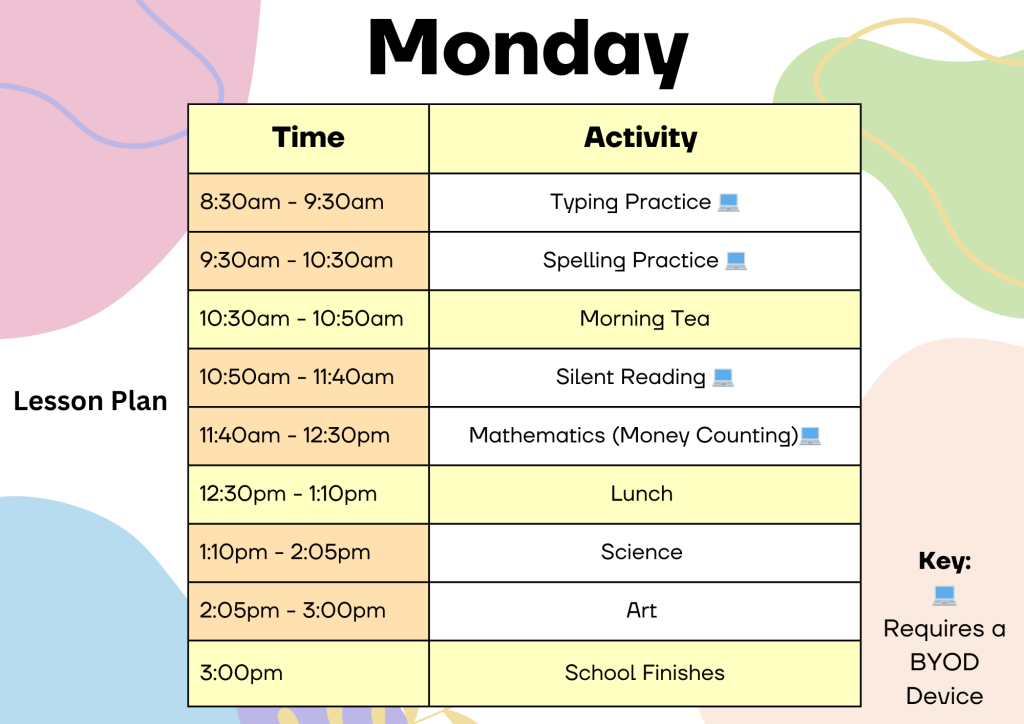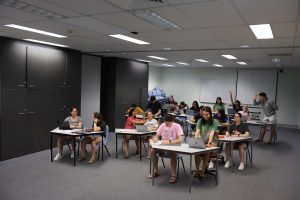Unit 5: The Application of Ergonomic Principles in Constructing and Customising Individuals BYOD Device Use within Home and School Contexts
Learning Objective:
To apply the principles of ergonomics in constructing and customising individualised BYOD device use within school and home contexts in order to minimise risks and maximise educational outcomes.
This unit is designed to consolidate and reinforce the knowledge acquired throughout the open educational resource. By working through these questions, you will apply theoretical concepts to practical scenarios and deepen your understanding of ergonomics and BYOD device use within learning contexts.
You will be required to answer and self-check a series of questions based on the case study. After completing the questions, you will have access to detailed answers, however, this level of detail is not expected but is included to assist in understanding the answers. This self-check mechanism is an essential part of the learning process, enabling you to evaluate your responses and gain valuable insights into your understanding.
Case Study
Click here to download a printable version of the case study [PDF file]
Miss Honey works at a state primary school located in Townsville, Queensland, which has implemented a Bring Your Own Device (BYOD) program in all their classrooms this year. It has been in effect for two terms so far. The school serves a diverse community with varying socio-economic backgrounds and has made limited financial investment in ergonomic practices. The principal of the school is known for being approachable and has fostered a supportive environment for both students and staff.
Miss Honey’s grade 5 class consists of 20 students, each using either a laptop or a tablet as part of the BYOD program. The classroom is furnished with standard one-size chairs and desks with tidy trays arranged in a traditional line layout. Due to the amount of content Miss Honey aims to incorporate into her lessons each day, her students only have a break from learning during designated morning tea and lunch periods.

Since implementing BYOD devices, Miss Honey has observed a decline in her students’ performance and participation. As Miss Honey has limited experience with the BYOD program and ergonomic practices, she has reached out to you for assistance as a fellow teacher. During your free period, you visit Miss Honey’s classroom.

While in Miss Honey’s classroom, you have also identified students who could benefit from ergonomic recommendations to improve their classroom participation. To gain additional information about three of these students, you discuss them further with Miss Honey.
James is an attentive student, actively engages in classroom activities, and demonstrates respect for Miss Honey. He is also the tallest student in his cohort. Due to his long legs, James’ tidy tray has been removed from under his desk to provide more legroom. As a result, James’ desk is cluttered with all of his books and stationery. Recently, James has also been complaining about neck, back, and shoulder pain when using his tablet which has made focusing on learning tasks more difficult.
Charlotte is an eager learner and has developed a thorough understanding of proper posture due to both her parents being occupational therapists. Charlotte has low tone and uses various assistive technologies to meet her needs when using her tablet in class. These include a mouse, keyboard, footrest, specialised chair, and tablet raiser. Charlotte experiences headaches due to glare from her tablet which can add to her discomfort. She has also experienced cyberbullying via her school email address from classmates due to her use of assistive technology. Charlotte is therefore shy and has poor interpersonal skills.
Oscar enjoys using his laptop in the classroom, is a curious student, and has a high level of energy. His energetic nature can manifest in behaviours, such as running around the classroom, which can interfere with his peers’ and his own learning. Oscar also has difficulties grasping concepts as he experiences mental fatigue easily when completing classroom tasks. Therefore, Miss Honey has seated Oscar at the front of the classroom so that she is able to provide him with extra support. However, Oscar complains of feeling cold in this seating position as it is directly in front of an air conditioning unit. Fortunately, Oscar’s anthropometrics are well suited to the classroom furniture and he always ensures his desk remains clear of clutter.
You decide to also look at Miss Honey’s lesson plan and feel she could make some changes to improve performance and participation in the classroom.
Apply your Knowledge
Think of a student or individual in your class and use the Occupational Therapy Ergonomic Assessment, Sensory Audit Checklist, and Teacher Guide to Setting up a Student’s Ergonomic Learning Environment to identify the ergonomic factors affecting their performance and participation. Following this, identify changes you can make and the actions required to implement these recommendations.
Congratulations on reaching the end of our open educational resource! Thank you for your commitment and we hope the content provided enables you to enhance ergonomic outcomes for school-aged children in both school and home contexts.
– The Team


